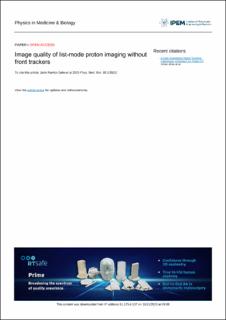| dc.contributor.author | Sølie, Jarle Rambo | |
| dc.contributor.author | Volz, Lennart | |
| dc.contributor.author | Pettersen, Helge Egil Seime | |
| dc.contributor.author | Piersimoni, Pierluigi | |
| dc.contributor.author | Odland, Odd Harald | |
| dc.contributor.author | Røhrich, Dieter | |
| dc.contributor.author | Helstrup, Håvard | |
| dc.contributor.author | Peitzmann, Thomas | |
| dc.contributor.author | Ullaland, Kjetil | |
| dc.contributor.author | Varga-Kofarago, Monika | |
| dc.contributor.author | Mehendale, Shruti Vineet | |
| dc.contributor.author | Grøttvik, Ola Slettevoll | |
| dc.contributor.author | Eikeland, Viljar Nilsen | |
| dc.contributor.author | Meric, Ilker | |
| dc.contributor.author | Seco, Joao | |
| dc.date.accessioned | 2020-12-14T08:22:53Z | |
| dc.date.available | 2020-12-14T08:22:53Z | |
| dc.date.created | 2020-08-26T12:23:36Z | |
| dc.date.issued | 2020 | |
| dc.identifier.citation | Sølie, J. R., Volz, L., Pettersen, H. E. S., Piersimoni, P., Odland, O. H., Röhrich, D., … Seco, J. (2020). Image quality of list-mode proton imaging without front trackers. Physics in Medicine & Biology, 65(13) | en_US |
| dc.identifier.issn | 0031-9155 | |
| dc.identifier.uri | https://hdl.handle.net/11250/2718986 | |
| dc.description.abstract | List mode proton imaging relies on accurate reconstruction of the proton most likely path (MLP) through the patient. This typically requires two sets of position sensitive detector systems, one upstream (front) and one downstream (rear) of the patient. However, for a clinical implementation it can be preferable to omit the front trackers (single-sided proton imaging). For such a system, the MLP can be computed from information available through the beam delivery system and the remaining rear tracker set. In this work, we use Monte Carlo simulations to compare a conventional double-sided (using both front and rear detector systems) with a single-sided system (only rear detector system) by evaluating the spatial resolution of proton radiographs (pRad) and proton CT images (pCT) acquired with these set-ups. Both the pencil beam spot size, as well as the spacing between spots was also adjusted to identify the impact of these beam parameters on the image quality.
Relying only on the pencil beam central position for computing the MLP resulted in severe image artifacts both in pRad and pCT. Using the recently extended-MLP formalism that incorporate pencil beam uncertainty removed these image artifacts. However, using a more focused pencil beam with this algorithm induced image artifacts when the spot spacing was the same as the beam spot size. The spatial resolution tested with a sharp edge gradient technique was reduced by 40% for single-sided (MTF10% = 3.0 lp/cm) compared to double-sided (MTF10% = 4.9 lp/cm) pRad with ideal tracking detectors. Using realistic trackers the difference decreased to 30%, with MTF10% of 4.0 lp/cm for the realistic double-sided and 2.7 lp/cm for the realistic single-sided setup. When studying an anthropomorphic paediatric head phantom both single- and double-sided set-ups performed similarly where the difference in water equivalent thickness (WET) between the two set-ups were less than 0.01 mm in homogeneous areas of the head. Larger discrepancies between the two set-ups were visible in high density gradients like the facial structures. A complete CT reconstruction of a Catphan$^{\circledR}$ module was performed. Assuming ideal detectors, the obtained spatial resolution was 5.1 lp/cm for double-sided and 3.8 lp/cm for the single-sided setup. Double- and single-sided pRad with realistic tracker properties returned a spatial resolution of 3.8 lp/cm and 3.2 lp/cm, respectively. Future studies should investigate the development of dedicated reconstruction algorithms targeted for single-sided particle imaging. | en_US |
| dc.language.iso | eng | en_US |
| dc.publisher | IOP | en_US |
| dc.rights | Navngivelse 4.0 Internasjonal | * |
| dc.rights.uri | http://creativecommons.org/licenses/by/4.0/deed.no | * |
| dc.subject | proton radiography | en_US |
| dc.subject | proton computed tomography | en_US |
| dc.subject | list mode imaging | en_US |
| dc.subject | most likely path | en_US |
| dc.subject | image reconstruction | en_US |
| dc.title | Image quality of list-mode proton imaging without front trackers | en_US |
| dc.type | Peer reviewed | en_US |
| dc.type | Journal article | en_US |
| dc.description.version | publishedVersion | en_US |
| dc.rights.holder | © 2020 Institute of Physics and Engineering in Medicine | en_US |
| dc.source.pagenumber | 1-19 | en_US |
| dc.source.volume | 65 | en_US |
| dc.source.journal | Physics in Medicine and Biology | en_US |
| dc.source.issue | 13 | en_US |
| dc.identifier.doi | 10.1088/1361-6560/ab8ddb | |
| dc.identifier.cristin | 1825249 | |
| dc.relation.project | Norges forskningsråd: 250858 | en_US |
| dc.source.articlenumber | 135012 | en_US |
| cristin.ispublished | true | |
| cristin.fulltext | original | |
| cristin.qualitycode | 1 | |

